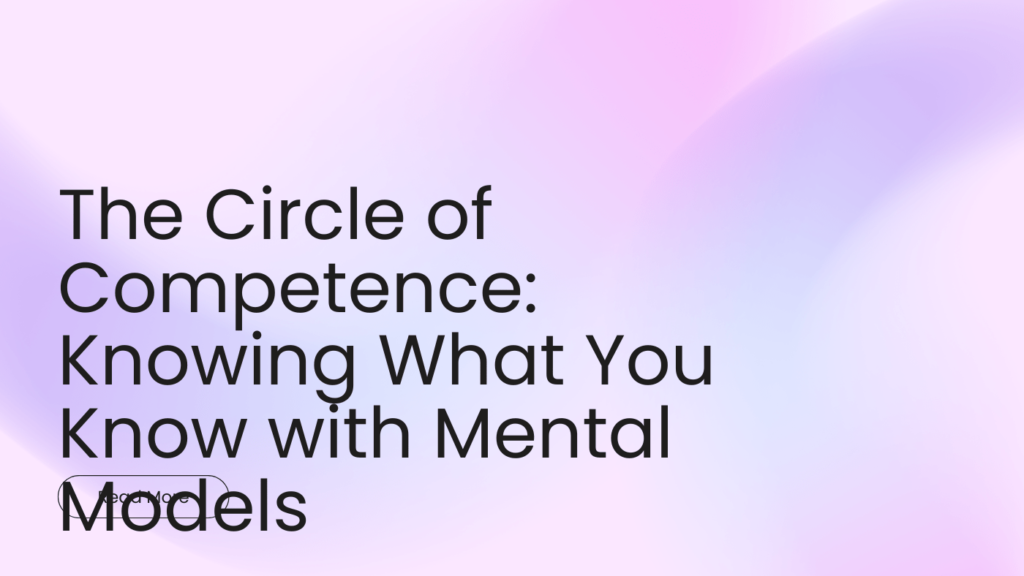The Circle of Competence: Knowing What You Know with Mental Models
In a world overflowing with information and complex decisions, mastering the art of knowing what you know – and, perhaps more importantly, what you *don’t* know – is paramount. This is where the concept of the “circle of competence” comes into play, fortified by the power of mental models. The circle of competence, championed by legendary investors like Warren Buffett and Charlie Munger, represents the boundaries of your expertise. Understanding and staying within these boundaries is crucial for sound decision-making, risk management, and achieving long-term success. This post explores the circle of competence, its relationship with self-awareness in decision making, and how mental models can help you define and expand it.
What is the Circle of Competence?
Imagine drawing a circle around everything you truly understand. Within that circle lies your circle of competence – the areas where you possess sufficient knowledge and experience to make informed judgments and predictions. This isn’t just about surface-level familiarity; it’s about deep, contextual understanding. You understand the key drivers, the potential pitfalls, and the likely outcomes of your decisions.
Warren Buffett emphasizes the importance of recognizing your circle of competence and avoiding investments outside of it. He famously stated, “Risk comes from not knowing what you’re doing.” By staying within your circle, you significantly reduce the chances of making costly mistakes based on incomplete or inaccurate information. Consider this advice in the context of self-awareness in decision making: acknowledging limitations allows for more rational and well-thought-out strategies.
The opposite of operating within your circle of competence is venturing into areas where you lack sufficient understanding. This often leads to speculation, gambling, and ultimately, losses. Think of it this way: would you perform brain surgery without years of medical training? Probably not. Similarly, avoid making critical decisions in areas where you lack the necessary expertise. The humility to admit “I don’t know” is a powerful asset.
The Importance of Self-Awareness in Decision Making
At the heart of defining and utilizing your circle of competence lies self-awareness. This isn’t just about knowing your strengths; it’s about acknowledging your weaknesses and limitations. Without honest self-assessment, you risk overestimating your capabilities and making decisions that fall outside your circle.
Self-awareness in decision making requires actively seeking feedback, reflecting on past experiences (both successes and failures), and constantly evaluating your knowledge base. It also means being open to challenging your own assumptions and biases. We all have blind spots, and recognizing them is crucial for making sound judgments. Daniel Kahneman, in his groundbreaking book *Thinking, Fast and Slow* (Kahneman, 2011), explores the cognitive biases that can lead us astray. Understanding these biases is essential for improving self-awareness and making more rational decisions.
Cultivating self-awareness is an ongoing process. It requires continuous learning, critical thinking, and a willingness to admit when you’re wrong. Embracing a growth mindset, as described by Carol Dweck in her book *Mindset: The New Psychology of Success* (Dweck, 2006), is also crucial. A growth mindset encourages you to view challenges as opportunities for learning and development, rather than threats to your ego.
Expanding Your Circle of Competence with Mental Models
While staying within your circle of competence is crucial for risk management, it doesn’t mean you should remain stagnant. One of the most effective ways to strategically expand your knowledge and improve self-awareness in decision making is through the use of mental models. Mental models are frameworks or shortcuts that help you understand and simplify complex systems. They are essentially tools for thinking.
Charlie Munger, a staunch advocate of mental models, describes them as “the latticework of mental models in your head.” He believes that having a diverse collection of mental models from various disciplines, such as psychology, economics, physics, and engineering, allows you to approach problems from multiple perspectives and make more informed decisions.
Here are some examples of mental models that can be particularly useful for expanding your circle of competence:
- First Principles Thinking: Breaking down complex problems into their fundamental truths and reasoning upwards from there. (Elon Musk is a well-known proponent of this.)
- Occam’s Razor: The simplest explanation is usually the correct one.
- Inversion: Solving problems by considering the opposite outcome. (Instead of asking how to succeed, ask how to fail.)
- The Pareto Principle (80/20 Rule): 80% of effects come from 20% of causes.
- Game Theory: Analyzing strategic interactions between individuals or entities.
By consciously learning and applying mental models, you can develop a deeper understanding of different domains and gradually expand your circle of competence. However, it’s important to remember that simply memorizing mental models isn’t enough. You need to actively apply them to real-world problems and reflect on the results. This process of experimentation and reflection is crucial for building true expertise. As Farnam Street’s Shane Parrish argues, true understanding comes from experience and application, not just theoretical knowledge (Parrish, n.d.).
Practical Steps to Define and Utilize Your Circle of Competence
- Conduct a Self-Assessment: Honestly evaluate your knowledge and skills in different areas. Where do you excel? Where do you struggle?
- Seek Feedback: Ask trusted colleagues, mentors, or friends for their honest assessment of your strengths and weaknesses.
- Reflect on Past Decisions: Analyze your past successes and failures. What factors contributed to the outcomes? What did you learn?
- Identify Your Blind Spots: Be aware of your cognitive biases and areas where you tend to overestimate your abilities.
- Focus on Continuous Learning: Read books, articles, and research papers in areas that interest you. Attend workshops and conferences.
- Apply Mental Models: Actively use mental models to understand complex systems and make better decisions.
- Stay Within Your Circle (Mostly): Avoid making critical decisions in areas where you lack sufficient understanding. If you must venture outside your circle, seek expert advice.
- Document Your Learning: Keep a journal or note taking system where you reflect on your experiences and how they relate to your circle of competence
Conclusion
The circle of competence is a powerful framework for improving decision-making, managing risk, and achieving long-term success. By understanding your limitations, cultivating self-awareness, and strategically expanding your knowledge with mental models, you can navigate the complexities of the world with greater confidence and effectiveness. Embracing the humility to admit “I don’t know” and the willingness to learn and grow are essential for mastering the art of knowing what you know.
References
- Dweck, C. S. (2006). *Mindset: The new psychology of success*. Random House.
- Kahneman, D. (2011). *Thinking, fast and slow*. Farrar, Straus and Giroux.
- Parrish, S. (n.d.). *Mental Models: The Best Way to Make Smart Decisions (& Improve Your Life)*. Farnam Street. Retrieved from https://fs.blog/mental-models/
“`


